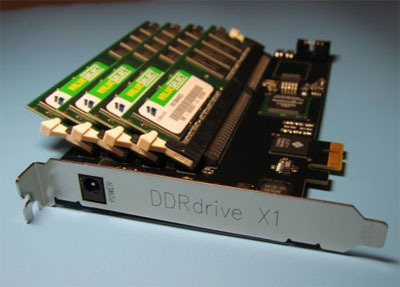DDRdrive uses PCIe to increase speed of mainstream solid state disks
Chicago (IL) - Gigabyte's i-Ram and HyperOs Systems' HyperDrive III solid state disk recently gave us a first impression that solid state storage is making its way into the mainstream: And there is more to come in the near future: DDRdrive will soon release a PCI Express device that uses external power to ensure the memory will not lose its stored data.
If the bandwidth offered by hard drives is not enough, users typically rely on what is referred to as Solid State Disks (SSDs) - storage devices that are built completely with memory chips. Such devices are typically horribly expensive and therefore used mainly in corporate, government or military environments. SSDs are available with Flash memory that is able to retain its content when the power source is removed, but often use (volatile) DRAM memory, which is the ultimate solution when performance is the main goal.
Gigabyte and HyperOS recently introduced boards that bring SSD technology into the mainstream market. Both devices are based on DRAM memory as storage technology and use integrated batteries to continuously supply the memory with power to avoid data loss. Soon there will be a new contender surfacing on the market: Colorado-based DDRdrive told TG Daily that it will be shipping its DDRdrive X1 in Q1 to compete with Gigabyte's i-RAM and HyperOs HyperDrive III, but offer a new approach to increase bandwidth and create a more reliable power supply for the memory.
Instead of using a SATA (i-RAM) or an UltraATA/100 interface (HyperDrive III), the DDRdrive will be based on PCI Express. According to DDRdrive's Christopher George, this will allow the DDRdrive to achieve significantly higher bandwidth than its competitors. The board can carry four DDR 184 pin DIMMs for a total capacity of 8 GB. There will be also an upgradeable "high performance" DMA engine.
According to George, the DDRdrive will not integrate a battery, as he believes that no on-board battery "can be large enough to allow the user to forget about power supply." He also mentioned that batteries increase the cost of such boards. DDRdrive's solution is a power adapter at the back of the board, which allows the user to connect the card directly to a power supply or a high-capacity external battery.
According to George, the DDRdrive currently is in its initial production run and will be "competitively" priced with the i-RAM. And even if power remains a concern - especially in areas with frequent power outages, the device should be able to spur the interest in high bandwidth data storage in the mainstream market.
Get Tom's Hardware's best news and in-depth reviews, straight to your inbox.
Tom's Hardware is the leading destination for hardcore computer enthusiasts. We cover everything from processors to 3D printers, single-board computers, SSDs and high-end gaming rigs, empowering readers to make the most of the tech they love, keep up on the latest developments and buy the right gear. Our staff has more than 100 years of combined experience covering news, solving tech problems and reviewing components and systems.

